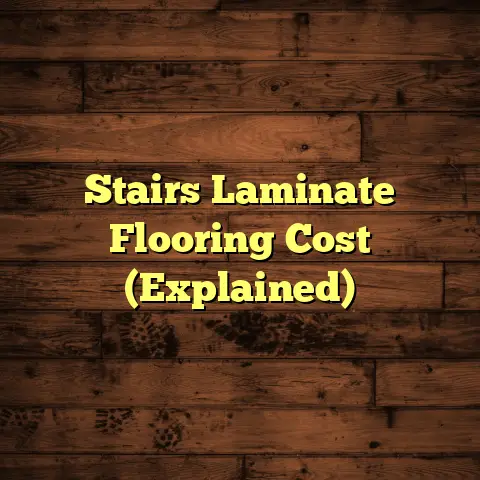Costs of False Flooring? (5 Factors Shock!)
I hear that a lot, and honestly, it’s a myth I’m eager to bust.
As a flooring contractor with years under my belt, I’ve seen firsthand how false flooring can be a game- changer for all sorts of businesses.
Sure, the initial price tag might raise an eyebrow, but let’s dive into the real costs – and the surprising benefits that often make it a smart investment.
We’re going to unpack the factors that drive the price of false flooring and see if it’s the right solution for you.
Section 1: Understanding
False Flooring
So, what exactly is false
flooring?
Think of it as a raised
floor built above the original
concrete slab.
This creates a hidden space for running all sorts of essential services – electrical and data cabling, HVAC systems, plumbing, you name it.
It’s like giving your building a super-organized, easily accessible utility basement within the floor.
Types of False Flooring
Now, there’s not just one type of
false flooring.
Here are a few
common ones:
Raised Access Flooring: This is the classic.
It consists of removable panels supported by adjustable pedestals.Perfect for offices, data centers, and anywhere you need easy access to under-floor utilities.
-
Modular Flooring: These are interlocking tiles or panels that can be quickly installed and reconfigured.
Great for temporary spaces, retail environments, or anywhere you need flexibility.
-
Panel Systems: Similar to raised access, but often with more integrated components and specific functionalities, like airflow management in data centers.
Each type has its own pros and cons, and the best choice depends on your specific needs and budget.
Section 2: Initial Costs of
False Flooring
Okay, let’s talk money. The initial cost of false flooring depends on several factors.
Material Costs
The materials used for the panels
and support structure play a big
role.
Here’s a quick rundown:
-
Steel: Durable and strong, ideal for high-traffic areas. Expect to pay a premium.
Aluminum: Lighter than steel and corrosion-resistant.
Good for data centers where weight is a concern.Wood: More aesthetically pleasing but less durable than metal.
Suitable for office spaces where looks matter.Vinyl: Often used as a surface finish on panels.
Cost- effective and easy to clean.
The choice of material can easily swing your budget by 20-30%, so consider the long-term durability and aesthetic requirements.
Installation Costs
Installation isn’t just slapping
down panels.
It involves careful
planning, leveling, and securing
the system.
Factors that affect installation costs include:
-
Labor Rates: Varies widely depending on your location and the contractor’s experience.
-
Complexity: A simple, open area will be cheaper to install than a space with lots of corners, columns, or existing obstacles.
-
Structural Mods: If your existing floor isn’t level or needs reinforcement, that adds to the cost.
Regional Variations
Location, location, location!
Just
like real estate, the cost of false
flooring can vary depending on where
you are.
Labor rates, material transportation costs, and local building codes all play a role.
For example, installing false flooring in New York City will likely cost more than in a rural area due to higher labor and material costs.
Section 3: Long-term
Financial Implications
Don’t just focus on the upfront
cost.
False flooring can save you
money in the long run.
Maintenance Costs
False flooring is generally easy
to maintain.
Regular cleaning and
occasional panel replacements are
usually all it takes.
However, consider these potential maintenance costs:
-
Cleaning: Special cleaning solutions may be needed for certain panel finishes.
Repairs: Panels can get damaged from heavy equipment or water leaks.
Replacement costs vary depending on the material.-
Upgrades: As technology changes, you might need to upgrade your cabling or HVAC systems, which could involve modifying the false floor.
Energy Efficiency
Here’s a cool benefit: false flooring can improve your building’s energy efficiency.
How? By creating a plenum (that empty space under the floor) for air circulation.
A well-designed system can distribute cooled or heated air more evenly, reducing the load on your HVAC system and lowering your utility bills.
I’ve seen buildings reduce their energy consumption by 15-20% just by optimizing airflow through a false floor.
Space Flexibility
This is where false flooring really
shines.
Need to move a workstation?
Add a new server?
No problem!
With false flooring, you can easily reroute cables and utilities without tearing up the entire floor.
This flexibility can save you big bucks in the long run compared to traditional flooring, where changes often involve costly and disruptive renovations.
Section 4: Hidden Costs and
Additional Factors
Now, let’s talk about the sneaky costs that often get overlooked.
Downtime During Installation
Installing false flooring can disrupt your business operations.
Think about the cost of lost productivity, temporary office space, and potential delays.
Careful planning and coordination with your contractor can minimize downtime, but it’s still a factor to consider.
Insurance and Liability
False flooring can impact your insurance premiums and liability.
A poorly installed or maintained system can create safety hazards, like tripping hazards or electrical risks.
Make sure your contractor is properly insured and that the installation meets all local building codes to avoid potential liability issues.
Aesthetic and Design Costs
While functionality is key, aesthetics matter too.
Custom panel finishes, unique layouts, and integrated lighting can add to the cost.
However, these design choices can also enhance the workplace environment and boost employee morale, so it’s worth considering the potential return on investment.
Section 5: The Value
Proposition
Okay, so we’ve covered the costs. But what about the value?
Return on Investment (ROI)
Let’s look at a hypothetical scenario:
Imagine a small tech company with
20 employees.
They’re planning to
move to a new office space and are
considering false flooring.
The initial cost is $50,000, but they estimate that the increased energy efficiency and flexibility will save them $10,000 per year in utility bills and renovation costs.
After five years, they’ll have recouped their initial investment and started seeing a positive ROI.
Plus, they’ll have a more adaptable and efficient workspace that can support their growth.
Comparative Analysis
How does false flooring stack up against traditional flooring?
Traditional flooring might be cheaper upfront, but it lacks the flexibility and accessibility of false flooring.
When you factor in the cost of future renovations, cable management, and potential energy savings, false flooring can often be the more cost-effective option in the long run.
Here’s a quick comparison table:
Market Trends
The demand for false flooring is growing, driven by several trends:
-
Sustainability: Businesses are looking for ways to reduce their environmental impact, and false flooring can contribute to energy efficiency and waste reduction.
-
Flexible Workspaces: The rise of remote work and hot- desking requires more adaptable office layouts, which false flooring can support.
-
Technology Integration: Modern offices rely on complex networks and data infrastructure, which false flooring can accommodate.
Conclusion
So, is false flooring an expensive option only for large corporations?
The answer is a resounding no.
While the initial cost might be higher, the long-term benefits – energy efficiency, flexibility, and accessibility – can make it a smart investment for a wide range of businesses.
By understanding the various factors involved, you can make an informed decision and determine if false flooring is the right solution for your needs.
Don’t let the myths scare you away.
Explore the possibilities and see
how false flooring can transform
your workspace.
I hope this article has helped you understand the true costs – and potential benefits – of false flooring.
If you have any questions or want
to discuss your specific needs,
feel free to reach out.
I’m always
happy to share my expertise.





